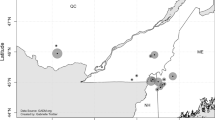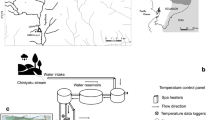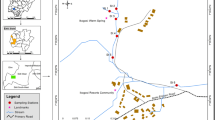Abstract
There is increasing concern about the effect of climate change on aquatic systems. We examined changes in macroinvertebrate communities caused by increased temperature (3°C above ambient during summer only and continuous 3°C above ambient all year round), influences of fish (Gasterosteus aculeatus L.) and addition of nutrients (nitrogen and phosphorus) in 48 large-scale (3000 l) tanks over a 2 year period. While numbers of Isopoda, Chaoborus, Corixidae, Ephemeroptera, Notonectidae and Odonata were reduced by the presence of fish, nutrient addition caused isopods, corixids, mayflies and odonates to increase in abundance. Impacts of temperature increase were surprisingly low, with only gastropods increasing in heated tanks, suggesting that, overall abundances of most macroinvertebrate taxa will not be severely affected by the predicted temperature rise. To determine if taxa were sampled representatively during the experiment, net sweep samples taken towards the end of the experiment were compared with final macroinvertebrate abundances when the complete contents of each tank were harvested. We found that net sweeping is an appropriate semi-quantitative method for most taxa in mesocosm tanks. However, mites, coleopteran adults and larvae, dipterans and Chaoborus were not adequately sampled. This might explain why we could not detect any treatment effects of temperature, fish or nutrients on mites, coleopterans and dipterans and calls for different sampling techniques for these taxa, especially in ponds with vegetation stands.


Similar content being viewed by others
References
Atkinson, D., 1996. Ectotherm life-history responses to developmental temperature. In Johnson I. A., A. F. Bennett (eds) Animals and Temperature: Phenotypic and Evolutionary Adaptation. Cambridge University Press, Cambridge: 183–204.
Baulch, H. M., D. W. Schindler, M. A. Turner, D. L. Findlay & M. J. Paterson, 2005. Effects of warming on benthic communities in a boreal lake: implications of climate change. Limnology and Oceanography 50: 1377–1392.
Connor, A. O., S. Bradish, T. Reed, J. Moran, E. Regan, M. Visser, M. Gormally & M. S. Skeffington, 2004. A comparison of the efficacy of pond-net and box sampling methods in turloughs – Irish ephemeral aquatic systems. Hydrobiologia 524: 133–144.
Costil, K. & J. Daguzan, 1995. Effect of temperature on reproduction in Planorbarius corneus (L) and Planorbis planorbis (L) throughout the life-span. Malacologia 36: 79–89.
Gurevitch, J. & S. T. Chester, 1986. Analysis of Repeated Measures Experiments. Ecology 67: 251–255.
Hogg, I. D. & D. D. Williams, 1996. Response of stream invertebrates to a global-warming thermal regime: An ecosystem-level manipulation. Ecology 77: 395–407.
Houghton, J. E. T., Y. Ding, D. J. Griggs, M. Noguer, P. J. van der Linden, X. Dai, K. Maskell & C. A. Johnson, 2001. Climate Change 2001: The Scientific Basis. Cambridge University Press, Cambridge, UK.
Humphries, P., J. E. Growns, L. G. Serafini, J. H. Hawking, A. J. Chick & P. S. Lake, 1998. Macroinvertebrate sampling methods for lowland Australian rivers. Hydrobiologia 364: 209–218.
IPCC 2007 Climate Change 2007: The Physical Science Basis -- Summary for Policymakers, which is available on http://ipcc-wg1.ucar.edu/.
Kiffney, P. M. & J. S. Richardson, 2001. Interactions among nutrients, periphyton, and invertebrate and vertebrate (Ascaphus truei) grazers in experimental channels. Copeia 2: 422–429.
Kozminsky, E. V., 2003. Seasonal dynamics of reproduction and reproductive parameters of Bithynia tentaculata (Gastropoda, Prosobranchia). Zoologichesky Zhurnal 82: 325–331.
Lewis, D. B. & J. J. Magnuson, 1999. Intraspecific gastropod shell strength variation among north temperate lakes. Canadian Journal of Fisheries and Aquatic Sciences 56: 1687–1695.
McKee, D., A. Atkinson, S. Collings, J. Eaton, I. Harvey, K. Hatton, T. Heyes, D. Wilson, L. Wolstenholme & B. Moss, 2000. Heated aquatic microcosms for climate change experiments. Freshwater Forum 14: 51–58.
McKee, D. & D. Atkinson, 2000. The influence of climate change scenarios on populations of the mayfly Cloeon dipterum. Hydrobiologia 441: 55–62.
McKee, D., D. Atkinson, S. Collings, J. Eaton, I. Harvey, T. Heyes, K. Hatton, D. Wilson & B. Moss, 2002a. Macro-zooplankter responses to simulated climate warming in experimental freshwater microcosms. Freshwater Biology 47: 1557–1570.
McKee, D., K. Hatton, J. W. Eaton, D. Atkinson, A. Atherton, I. Harvey & B. Moss, 2002b. Effects of simulated climate warming on macrophytes in freshwater microcosm communities. Aquatic Botany 74: 71–83.
McKee, D., D. Atkinson, S. E. Collings, J. W. Eaton, A. B. Gill, I. Harvey, K. Hatton, T. Heyes, D. Wilson & B. Moss, 2003. Response of freshwater microcosm communities to nutrients, fish, and elevated temperature during winter and summer. Limnology and Oceanography 48: 707–722.
Merritt, R. W., K. W. Cummins & V. H. Resh, 1996. Design of aquatic insect studies: collecting, sampling and rearing procedures. In Merritt R. W., & K. W Cummins (eds) An introduction to the aquatic insects of North America, 3 rd edn. Kendall/ Hull Publishing Company, Iowa 12–28.
Moss, B., G. Phillips & J. Madgwick, 1996. A guide to the restoration of nutrient-enriched shallow lakes. Broads Authority, WW Hawes, UK.
Moss, B., D. McKee, D. Atkinson, S. E. Collings, J. W. Eaton, A. B. Gill, I. Harvey, K. Hatton, T. Heyes & D. Wilson, 2003. How important is climate? Effects of warming, nutrient addition and fish on phytoplankton in shallow lake microcosms. Journal of Applied Ecology 40: 782–792.
Muzaffar, S. B. & M. H. Colbo, 2002. The effects of sampling technique on the ecological characterization of shallow, benthic macroinvertebrate communities in two Newfoundland ponds. Hydrobiologia 477: 31–39.
Noges, P., T. Noges, L. Tuvikene, H. Smal, S. Ligeza, R. Kornijow, W. Peczula, E. Becares, F. Garcia-Criado, C. Alvarez-Carrera, C. Fernandez-Alaez, C. Ferriol, R. M. Miracle, E. Vicente, S. Romo, E. Van Donk, W. van de Bund, J. P. Jensen, E. M. Gross, L. A. Hansson, M. Gyllstrom, M. Nykanen, E. de Eyto, K. Irvine, D. Stephen, S. Collins & B. Moss, 2003. Factors controlling hydrochemical and trophic state variables in 86 shallow lakes in Europe. Hydrobiologia 506: 51–58.
Rosenberg, D. M. & V. H. Resh, 1992. Introduction to freshwater biomonitoring and benthic macroinvertebrates. In: Rosenberg D. M., V. H. Resh (eds) Freshwater biomonitoring and benthic macroinvertebrates. Chapman & Hall, New York, London 1–9.
Sagarin, R. D., J. P. Barry, S. E. Gilman & C. H. Baxter, 1999. Climate-related change in an intertidal community over short and long time scales. Ecological Monographs 69: 465–490.
Schiermeier, Q., 2004. Modellers deplore ‘short-termism’ on climate. Nature 428: 593–593.
Stark, J. D., 1993. Performance of the macroinvertebrate community index – Effects of sampling method, sample replication, water depth, current velocity, and substratum on index values. New Zealand Journal of Marine and Freshwater Research 27: 463–478.
Walker, I. R., J. P. Smol, D. R. Engstrom & H. J. B. Birks, 1991. An assessment of chironomidae as quantitative indicators of past climatic-change. Canadian Journal of Fisheries and Aquatic Sciences 48: 975–987.
Acknowledgements
We are grateful to Rob Marrs, Chris Harrod, Emma Cox and Keith Hatton for help with statistics, to Dave Wilson, Keith Hatton and Tom Heyes for help with sampling and experimental maintenance, S.E. Collings and J.W. Eaton for valuable advice and to Andrew B. Gill for stickleback expertise. Parkside Engineering, JBC Control Systems Ltd. are thanked for installation of the facility, the Natural Environment Research Council for grant GR3/11438 supporting D. McKee and the EU grant EUROLIMPACS supporting H. Feuchtmayr.
Author information
Authors and Affiliations
Corresponding author
Rights and permissions
About this article
Cite this article
Feuchtmayr, H., McKee, D., Harvey, I.F. et al. Response of macroinvertebrates to warming, nutrient addition and predation in large-scale mesocosm tanks . Hydrobiologia 584, 425–432 (2007). https://doi.org/10.1007/s10750-007-0588-7
Issue Date:
DOI: https://doi.org/10.1007/s10750-007-0588-7




